WORLD CLASS COACHING
Club Curriculum Building a Better Goalkeeper
By Tony Englund
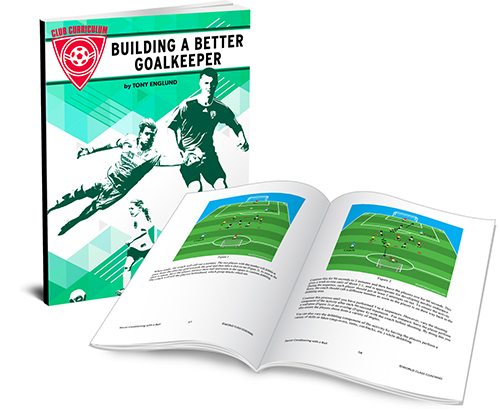
TABLE OF CONTENTS
Part Two
TRAINING SESSIONS
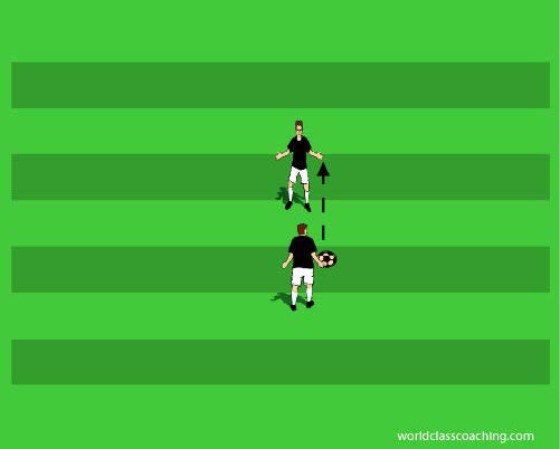
One –Hand Catching in Pairs - 6x4 yard space
Players work in pairs with one ball. The goalkeepers stand four yards from one-another and play catch. Instruct players to throw and catch with one hand and to alternate the hand that they use each time. The receiving player should indicate which hand is the target by raising that hand to shoulder height before the throw. Serves need to be shoulder-high to be effective. The most useful coaching points here are to emphasize the importance of concentration, balance, meeting and absorbing the ball with every save. Advanced goalkeepers benefit from this training in that they can learn to develop very soft touch on the ball through extending their hand out to meet and control the serve. After two minutes, the goalkeepers back up two steps and throw harder, with the same soft and clean receptions being the goal.
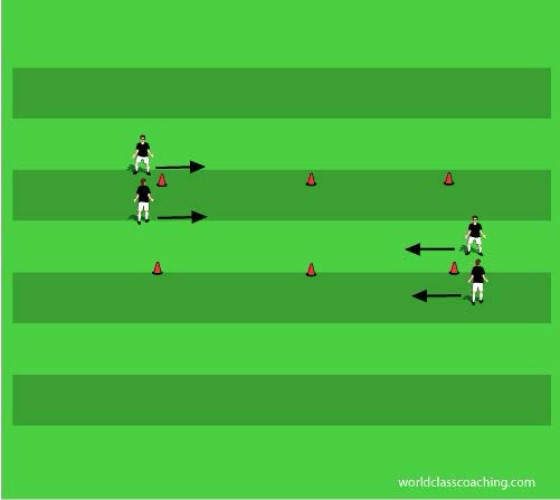
Line Shuffle with Handling - 15-yard cone lines 6 yards apart.
The partners face each other with one of the two rows of cones between them. First, they stand for 5 seconds in their ready position. Then they shuffle together the length of the cone line and then move to the other cone line and shuffle back (reverses footwork). This environment combines the concepts (stance and footwork) introduced in session#1 with the catching introduced in this session.
Progression
• Add a ball and chest pass throughout the footwork.
• Add a ball and bounce pass throughout the footwork.
• Add two balls (advanced): One partner chest-passes and the other bounce passes throughout the footwork. One partner chest passes and the other returns the ball at knee height.
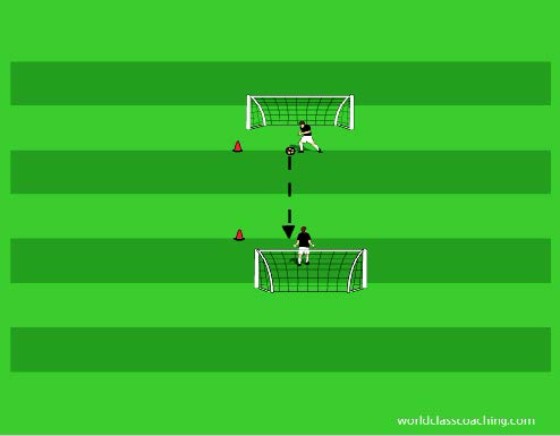
Goalkeeper Wars - 2 goals 14 yards apart
This is the most popular pairs training game for goalkeepers, and it is a very good coaching environment as well, as the technical concepts introduced in many of the earlier exercises can be tested here without specific prompt. The general set-up involves two full-sized goals placed 14yards apart (use age-appropriate goals and distance). Place two cones 3 yards from each goal line beyond which players cannot venture to shoot (they may go out and collect rebounds as long as they return to their area to shoot). Players alternate shooting opportunities. Award a point for a goal and also a point for good footwork and catching.
Training Session#3: Handling and Distribution: Comfort on the Ball
Introduction
This session continues the theme of developing in players a thorough understanding of proper receiving. This practice also introduces distribution techniques and provides efficient, fun training environments that give players intensive repetition.
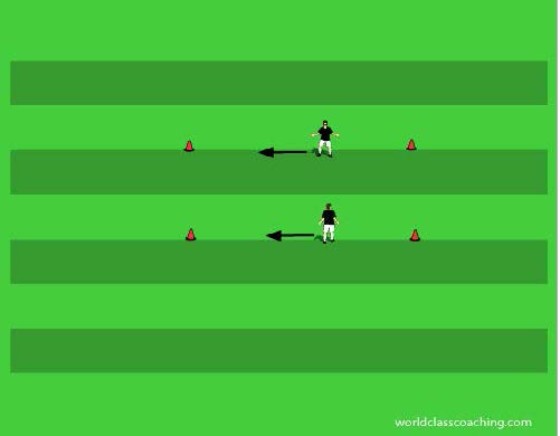
Line Mirrors and Races - Place two sets of cones 6 yards apart as shown
The work area is the width of the goal (for U11/U12). Goalkeepers face one-another. One leads and the other follows. To begin, only shuffling is allowed and goalkeepers must keep their feet, hands and shoulders facing their partner at all times. The leading goalkeeper shuffles back-and-forth, working her partner between cones. After 10 seconds, she attempts to touch either of her cones before her partner can touch her corresponding cone. If she is successful, her partner becomes the leader.
Progression
• Allow a crossover step to quicken the pace. This exercise is designed to get goalkeepers to quicken their footwork and their ability to change directions across the face of the goal. Many goalkeeper errors are rooted in a need to get their feet going earlier and to get in line with the ball as it travels. The need to keep the shoulders, hips and feet facing forward is also paramount, as the only diving possible with the body facing the post is stomach diving, which is dangerous, produces rebounds and limits range. When the goalkeeper has to cover the width of the goal quickly, a cross-over step can be used, but should be followed by shuffling to make fine adjustments and align the body to receive the ball.
Follow the Leader Individual Handling. Each goalkeeper has a ball. One goalkeeper leads and the other mimics her handling and footwork. Change roles after 30 seconds.
• Pushing the ball back in forth between hands in the ready position (use the fingers and make the hands soft) and then above and in front of the head.
• Bounce and catch the ball (focus on creating a “W” with the thumbs and pointer fingers of each hand on the back of the ball). Explain that this position is the ideal catching posture for all balls received above the base of the rib cage. Encourage players to bounce the ball in an arc, to their sides, behind one foot, etc. In every case, emphasize that the goalkeeper must both catch the ball and then take a moment to look at and secure the ball before bouncing again. If young goalkeepers get in the habit of receiving and then securing the ball before moving on, they will develop both good concentration on the save and also good catching habits that will limit the number of drops.
• Skip and catch.
• Toss a high ball and catch.
• Sit down and “ride a bike” (in a ¼ sit-up position, work the ball between the legs while creating a biking motion)
• Work the ball in a circular motion around one leg (using both hands), working the ball from the knee down to the ankle and back up again – change legs).
• Figure “8” with the finger tips (ball on the ground). Emphasize that the fingers must be able to instinctively feel the ball for the goalkeeper’s handling to be sharp.
• Handling challenges – 1. Hold the ball with both hands behind the knees; flip the ball upward and forward and catch the ball in front of the knees. 2. Staggered hands (one in front of one knee and one behind the other) hold the ball; flip the ball up and alternate the hand position before catching.
• Recovery handling. The goalkeeper lays on her back (or front), tosses the ball up in the air and gets to her feet before catching (do not let the ball bounce).
• Roll the ball along with the fingertips at walking pace (to the side of the body), changing sides and then picking the ball up and bouncing and catching to add variety.
Catching and Distribution Series.
This is the classic set of receiving and releasing options available to goalkeepers. The exchanges outlined here can be part of a warm-up or a regular rehearsal of involved techniques. Here is the progression, with a few key technical cues for each element:
• Chest pass and catch. The catch involved here is the standard form of catch for a ball received between eye height and the base of the ribs. From the ready position, the hands are extended and raised to meet the ball with the “W” position established behind the ball.
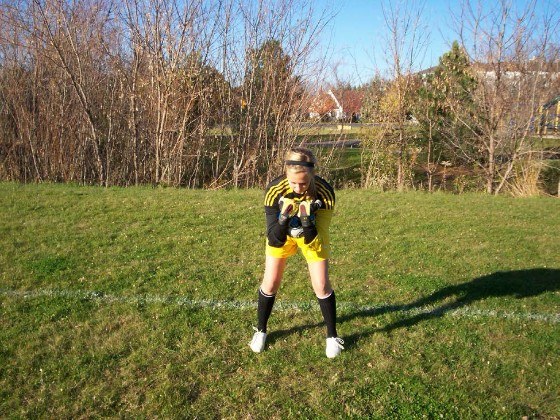
• “Gut” balls. From an underhand serve, the receiving ‘keeper turns her palms up to receive the ball between stomach height and the shoe-laces. In addition to a quick hand adjustment, the goalkeeper must also tuck her elbows in behind the ball to create a stable receiving area and organize her frame and balance behind the ball.
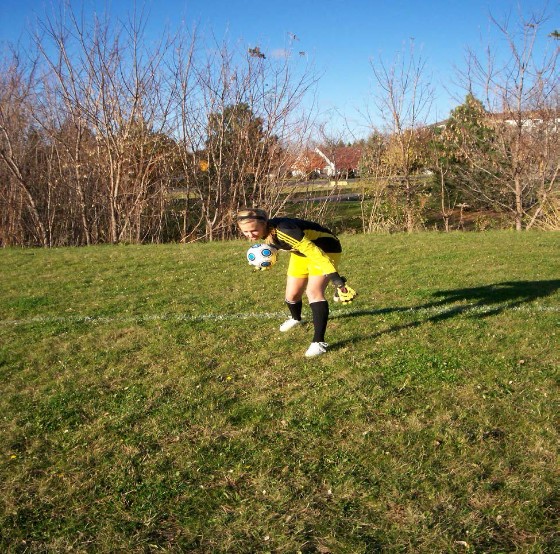
• Ground distribution. The serve is commonly referred to as a “bowled” pass, with the goalkeeper reaching down to the ground and releasing a ball that should not bounce. This pass is used for very short distances (i.e to distribute to the outside backs).
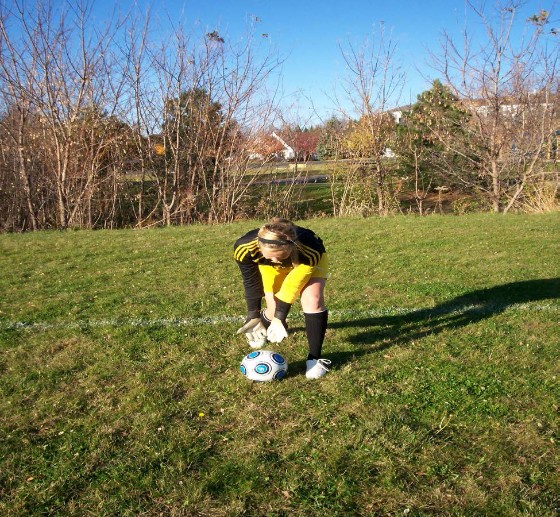
• Ground pick-up. On the receiving end, the standard save involves staggering the feet (forward and back) slightly bending the knees, and then getting the hands and elbows tucked in behind the ball. Where possible, this should be a standing save (no kneeling) and for advanced goalkeepers, receiving the ball as early as possible is a major point of emphasis.
• Skipped Distribution. The goalkeepers back off to 12-15 yards away from one-another. This is a middle-distance distribution where the goalkeeper drops the shoulder and pushes down with the fingers on the throwing hand to create backspin (reduces bounce – like a chip). The throw should travel about ½ of the distance in the air. The receiving goalkeeper focuses on collecting the ball cleanly and early.
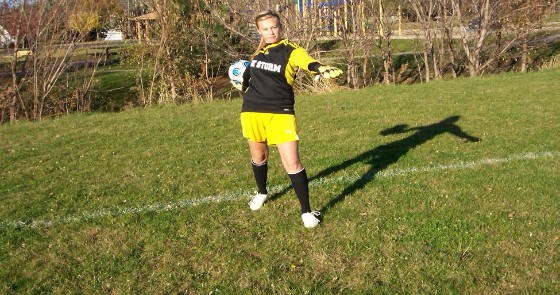
• Thrown Distribution. Keeping the same distance, the goalkeepers practice full thrown distribution (this is for middle to long distribution). Emphasize cupping the ball between the wrist and fingers and a wind-mill motion (shift weight from back foot to front foot). Some goalkeepers like a more sidearm release, but this can be problematical, as it is difficult to control the height and sometimes the release point of the ball. Coming over the top allows for maximum velocity to develop and also assures the ball will be released in the proper direction. The target for these throws is the partner’s shoulders, and the receiving player should focus on extending her hands for clean receiving.
• High Ball Receiving. This is the toughest save for most young goalkeepers. The service here needs to be underhand and in such a way that the partner can always come forward to receive. The key components to a clean save are proper approach and preparation; take off on one foot, driving the opposite knee forward and high to aid the jump; receive the ball with both hands above and in front of the head (minimizes the likelihood of a field player getting to the ball first and also of the ball getting in behind the goalkeeper); finish the save either by stabilizing the ball in front of the body or by pulling the ball down to the chest.
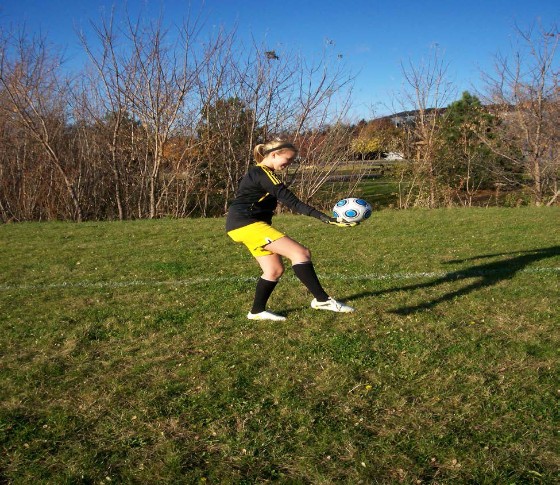
• Punt and Catch. The goalkeepers short-punt the ball three-to-five yards. This is an effective exercise both for keeping the punting motion and touch surface sharp and for reactions catching. The punting motion should be consistent (try to punt at the partner’s chest) and release point should be such that the goalkeeper does not kick too low (release is too early) or punt high without any distance (late release, catching the foot at the end of the kicking motion).
Goalkeeper Wars - 2 goals 14 yards apart
This is the most popular pairs training game for goalkeepers, and it is a very good coaching environment as well, as the technical concepts introduced in many of the earlier exercises can be tested here without specific prompt. The general set-up involves two full-sized goals placed 14yards apart (use age-appropriate goals and distance). Place two cones 3 yards from each goal line beyond which players cannot venture to shoot (they may go out and collect rebounds as long as they return to their area to shoot). Players alternate shooting opportunities. Award a point for a goal and also a point for good footwork and catching.
Training Session#4: Pairs Shot-stopping: Building Confidence Through Repetition.
2-Ball Speed Work
One method of applying a bit of pressure to handling sequences is to introduce a second ball. This compels the goalkeeper to manage receiving and releasing in a very tight time window and is a very good preparation for shot-stopping. In the first sequence, one goalkeeper chest passes and the other goalkeeper tosses the ball at knee level. Emphasize to the player making the lower pass that they need to catch the ball, lower it and push the ball straight ahead (to avoid balls colliding in mid-air). For advanced goalkeepers, one partner or the coach can call, “Switch!” (alternate the passing role) while the work is in progress to see if the players can keep concentration and maintain their rhythm.
Progression
• One player bounce passes and the other player chest passes.
• The goalkeepers stand at staggered points and toss straight ahead before shuffling sideways to receive their partner’s toss. For younger goalkeepers, this last challenge can be carried out with rolled balls if they struggle to get to a tossed ball.
Classic Reactions Catching
This series is useful for providing very quick repetition. The goalkeepers work through the progression below, alternating roles every 10 shots. In each case, vary serves – thrown, punted, drop-kicked, shot from ground. The major coaching points with this type of intense training work are enforcing the importance of good hand-eye coordination and extending the catching area to reduce the number of rebounds.
• Goalkeeper looks down; partner calls, “Shot!” and she reacts to save.
• Goalkeeper faces away from her partner. At the call of, “Shot!,” she turns and reacts to save.
• Goalkeeper starts on the post, facing the corner flag. At the call of, “Shot!,” she turns to deal with shot from her partner in the area.
• Goalkeeper starts laying on her front side and looking down. At the call of , “Shot!,” she recovers and reacts to save.
• Goalkeeper starts laying on her back and looking up. At the call of, “Shot!,” she recovers and reacts to save.
Balls and Strikes - Utilize an 8x8 yard grid
Goalkeepers stand on opposite sides of the grid. The players throw the ball back and forth, attempting to force their partner to drop the ball. Each dropped ball is a strike and the first player to accumulate three strikes loses the game. For a throw to result in a strike, it must be thrown between the shoulders and between the chin and waist on the target goalkeeper – and be dropped. Any throw outside that area is a ball. Accumulated balls do not count in the scoring of the game. From a coaching perspective, this game is a good environment for getting goalkeepers to focus on reactions, controlling high paced shots, and consistency.
Long Shot Short Shot
Here the sequence is a long shot from 15 yards (younger goalkeepers can punt this shot if need be) followed immediately by a short shot from 10-12 yards. For the first shot, the goalkeeper stays near her line and patiently handles the serve. As soon as she has handled this first shot, she must quickly move off of her line to challenge the shooter’s second effort. This is a realistic exercise that teaches goalkeepers to assess quickly their starting position and differentiate between the various distances from which a shot can come. Change roles/goalkeepers after three minutes.
Training Session#5: Safety Diving: Proper Technique.
Introduction: Young players typically are very enthusiastic, but not overly concerned with safety and proper form, when learning to dive. This session lays out key technical aspects (and safety considerations) for diving in simple, efficient training environments that also provide some fun for the goalkeepers as they learn.
Pairs Diving Progression
One goalkeeper begins on her knees on the endline. Her partner holds the ball. The server rolls balls to alternating sides for the working goalkeeper to save. The goalkeeper dives to save on either side.
Key technical diving considerations:
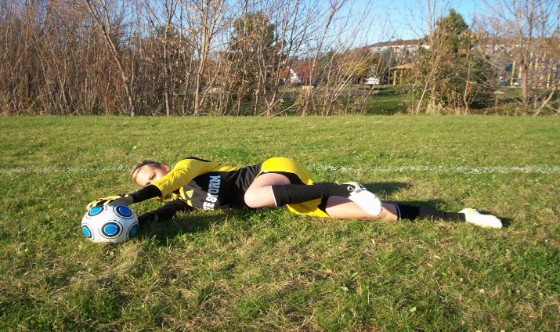
• Contact points for the body in the dive are the outside of the knee, the hip and the shoulder (do not land on the elbow!).
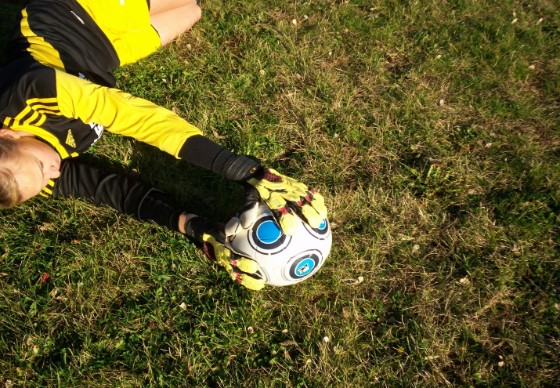
• Receive the ball with two hands and at eye level, with the near-side hand on the back of the ball and the trailing hand on top of the ball.
• Young ‘keepers are taught to consider the ground to be a “third hand” with which to control the ball.
• The elbows should be slightly bent and act as springs to cushion hard serves and any attempt by an opponent to kick the ball.
• The head is raised off of the ground, with the eyes focused on the ball throughout. The trailing knee is kicked in front of the body and up to stomach level (the knee should not be any higher off of the ground than the hip). The recoil from this movement will help the goalkeeper recover to her feet after the save.
• The most common errors are stomach-diving (emphasize contact points); improper hand placement; and failing to bring the knee forward, which both leaves the goalkeeper vulnerable and often results in the goalkeeper rolling on her back at the end of the save); sideways or backward dive angle (work to get the shoulders and hands forward with each dive).
Progression
• Serves in the air.
• Bounced serves.
• Repeat the progression with the goalkeeper working from a standing position.
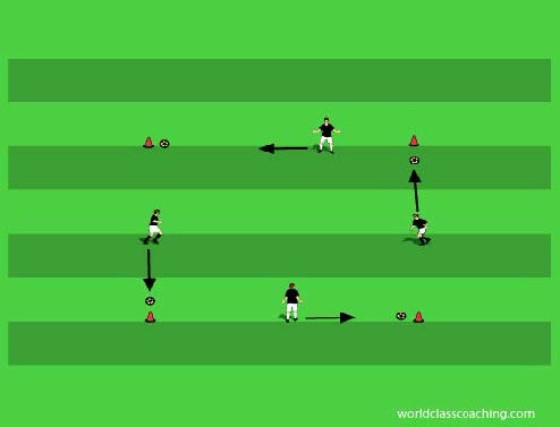
Grid Races - 10x10 yard grid
A ball is placed next to each corner cone. The goalkeepers start on the perimeter of the grid, face inward and move in the same direction. The goalkeepers must use footwork to close on and cover each ball on the perimeter. The first goalkeeper to catch (tag) her partner wins. This is a grueling fitness exercise that puts a lot of strain on the goalkeepers’ technique, and should only last a minute or so. Play once in each direction.
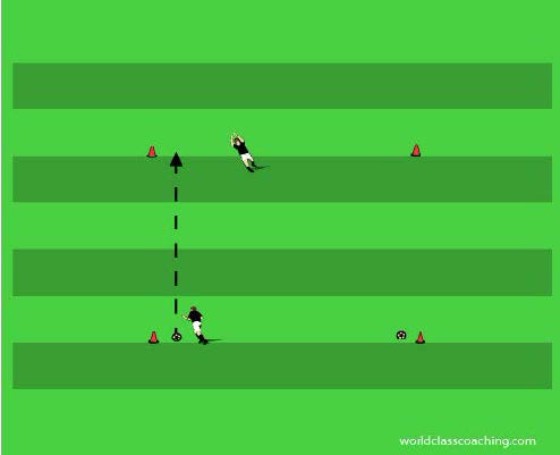
Dive and Recover - 10x10 yard grid
As the slide indicates, goalkeepers begin on opposite sides of the grid with balls located in the two corners on one end. The goalkeeper with the balls on her end is the attacker to begin, and she moves to one corner and sends the ball straight ahead for the goalkeeper to dive and save (leave the ball right at the cone after the save). The attacker then moves to the other side and strikes the second ball straight ahead for the goalkeeper to dive and save. Now the roles reverse as both goalkeepers move to the center of their respective ends of the perimeter before the restart. This is a very good environment for teaching recovery, as the time between the first and second shots can be very short if the attacker moves right away.
Goalkeeper Wars - 2 goals 14 yards apart
This is the most popular pairs training game for goalkeepers, and it is a very good coaching environment as well, as the technical concepts introduced in many of the earlier exercises can be tested here without specific prompt. The general set-up involves two full-sized goals placed 14yards apart (use age-appropriate goals and distance). Place two cones 3 yards from each goal line beyond which players cannot venture to shoot (they may go out and collect rebounds as long as they return to their area to shoot). Players alternate shooting opportunities. Award a point for a goal and also a point for good footwork and diving saves. For the first phase of the game, compel shooters to play the ground to encourage diving by the target goalkeeper.


